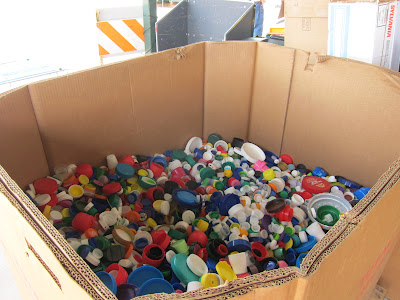

Low-waste efforts at this year's
YWCA triathlon at Lake Nokomis went great!!! Here are the numbers!
organics: 536 pounds
cardboard: 104.4 pounds
bottles and cans: 42.1 pounds
non-bottle plastic containers: 19.6 pounds
plastic film/bags: 8 pounds
trash: 57.6 pounds
for a diversion rate of
92 percent!
There were 1,000 racers, 300+ volunteers and hundreds of spectators, and they produced 57 pounds of trash -- mostly plastic Starbucks and Caribou cups, diapers, energy bar wrappers and other plastic food containers. After
my efforts at last year's Tri bombed, I was determined to fix things for this year's race. And I'm so happy to say I did!
Lessons learned:
1. Reduce packaging on the front end.
2. Go ahead of time to check out the site. I knew the site from last year, but this year I did partial set-up the day before the race, which helped a ton.
3. Have enough volunteers to man the disposal stations.
4. Move the Parks Department's trash barrels yourself.
5. Rent enough organics carts. This year we rented nine; last year's three weren't anywhere near enough.
6. Tape your signs on the day before because all your containers are covered with dew at 5 a.m.
This post will have a ton of pictures, since I want to acknowledge everyone who played a part in this big effort!
My early morning crew of volunteers.
GreenCorps member Will Dolezal provided excellent, knowledgable assistance.

Lisa

Heather

Virginia (who helped me both Sat. and Sun.)

and Kris. Don't they look incredibly cheerful considering they started at 5 a.m.?

Yeah, the beach looks empty now, but ...

here was the scene just before the start.

One important consideration for this year's waste was reducing the amount of packaging for the race food. Last year the sandwich wraps came on plastic trays with plastic lids, and there were hundreds of single-serving chip bags and granola bar wrappers. This year's food-packaging situation was MUCH different. Head food procurer Kelli Klein went the extra mile to get sandwich wraps from
D. Brian's on reusable steel trays.

Kelli also did not buy any single-serving packages of food for the race. For budget reasons, she shopped at Costco, which as many of you know is top-heavy in the packaging department. So there really was no way of getting around the plastic containers from Costco.

It was Kelli's idea to do a trail mix-type offering, which was a great way of avoiding single-serving packaging.

Carts Kelli borrowed from D. Brian's to hold the sandwich wraps.

A water station. No plastic water bottles provided to racers.

My late-morning crew of volunteers. Post-race was very busy because everyone was eating and re-fueling.
Here's Will again, still energetic hours after arriving!

Angela

Sara

Dominic, Nicky and Sofie

The massive food tent


Compostable cups, plates and napkins


536 pounds of organics squished into nine 64-gallon carts.

The trash from our 9-hour event.

The key YWCA people without whom the low-waste effort wouldn't've been possible:
Race director Nicole Cueno was the driving force behind the green initiatives. She really wanted to make the race environmentally friendly, and did the legwork that comes with making that happen. Nicole was just fantastic to work with!

Head food procurer Kelli Klein, who was such a great partner in reducing the amount of packaging for this year's race. From Kelli: "I'm a sucker for numbers and scores. I'm already wondering how I can get us to 99% [diversion] next year!"

Volunteer coordinator Sarah Raser, who got me all my volunteers, without whom the effort would've failed!

And Christine Sharpe (in sunglasses), who dove right in just when I needed her and helped me separate organics from trash when 3 unmanned bins were overflowing.

The race bags were 40% post-consumer and 60% pre-consumer recycled polypropylene. Other green initiatives undertaken by the Tri: online-only registrations, information on carpooling, busing and biking to the event on the race's Web page, a bike valet, shoe recycling offered at packet pickup, race shirts made of recycled polyester, and half as many postcards were printed as last year, and those were printed on recycled paper with soy-based inks. I'll be documenting our efforts for
FitPlanet's Pledge of Sustainability.
 Back in May, I blogged about the Fulton Farmers Market and how I hoped they'd start collecting their organics for recycling soon. Looks like that's not in the cards till next year, but at the upcoming Fulton Fall Festival, which this year is going to be side by side with the farmers market on Sept. 10, I'll be making it low-waste as usual (also hoping for less waste than last year), so the market folks said I could collect organics at the market, too, that day. So I'm lining up volunteers and doing the planning for that. As part of my planning, I scoped out the waste situation at the farmers market last Sat. since I hadn't been there for a while. Here was the waste composition:
Back in May, I blogged about the Fulton Farmers Market and how I hoped they'd start collecting their organics for recycling soon. Looks like that's not in the cards till next year, but at the upcoming Fulton Fall Festival, which this year is going to be side by side with the farmers market on Sept. 10, I'll be making it low-waste as usual (also hoping for less waste than last year), so the market folks said I could collect organics at the market, too, that day. So I'm lining up volunteers and doing the planning for that. As part of my planning, I scoped out the waste situation at the farmers market last Sat. since I hadn't been there for a while. Here was the waste composition:
























































